2015 AUDI TT ROADSTER run flat
[x] Cancel search: run flatPage 5 of 244

Knee airbags . . . . . . . . . . . . . . . . . . . . . 123
Side airbags . . . . . . . . . . . . . . . . . . . . . 125
Child Safety . . . . . . . . . . . . . . . . . . . 129
Important things to know ......... .
Child safety seats ................ .
Instal ling a chi ld safety seat .. .. .. . .
Additional Information ........... .
Vehicle operation ............ .
Intelligent technology .. .. .. . .
Notice about data recorded by vehicle
control modules .............. ... .
Electronic Stabilization Control (ESC) .
Rear spoiler ................ ... . .
Braking ........................ .
E lect ro-me chan ical power assis t ... . .
D riving w ith your quattro ......... .
Energy management ............. .
Driving and environment .....
The first 1,000 miles (1,500 km) and
afterwards .............. .. .. .. . .
Avoid damaging the vehicle ........ .
Driving through water on roads ... . .
Catalytic converter ............... .
Shutting down vehicle ............ .
Operate your vehicle economically and
minimize pollution ............... . 129
134
137
140
141
141
141
14 1
143
144
145
1 46
146
1 4 9
149
150
150 150
151
15 1
Tra iler towing . . . . . . . . . . . . . . . . . . . . 153
Vehicle care . . . . . . . . . . . . . . . . . . . 154
Vehicle care and cleaning . . . . . 154
General information . . . . . . . . . . . . . . 154
Car washes . . . . . . . . . . . . . . . . . . . . . . 154
Cleaning and care information . . . . . . 155
Fuel supply and filling your
fuel tank . . . . . . . . . . . . . . . . . . . . . . .
160
Gasoline . . . . . . . . . . . . . . . . . . . . . . . . 160
Fuel tank. . . . . . . . . . . . . . . . . . . . . . . . 161
Checking and filling . . . . . . . . . . . 164
Engine hood . . . . . . . . . . . . . . . . . . . . . 164
Eng ine oil . . . . . . . . . . . . . . . . . . . . . . . 166
Eng ine cooling system ............. 171
Brake fluid ...................... 174
Table of contents 3
Battery . . . . . . . . . . . . . . . . . . . . . . . . . 175
Windshield/headlight washer
container . . . . . . . . . . . . . . . . . . . . . . . 179
Tires and wheels ........... .. .
Tires ..... .. .... .. . .. .......... .
Tire pressure monitoring system ... .
Run-flat tire s .. .. ............... .
Do-it-yourself service ........ .
What do I do now? ........... .
Trunk escape handle ............. .
Vehicle tool kit .... .............. .
T ire repai r .... ... .. ............. .
What should I be aware of when
h . t
' 7 c angmg a ire .................. .
Fuses and bulbs .. .. .. ..... ... .
El ectr ical fuses . .. .. ............. .
Bulbs .......................... .
Emergency situations ........ .
General ........................ .
Starting by pushing or towing ...... .
Starting with jumper cables ....... .
U se of jump er cables ............. .
Emergency towing with commercia l
tow truck ...................... .
Lifting vehicle .. .. ............... . 180
180
198
201
204
204
204
204
205
208
212
212
215
2 16
216
216
216
217
218
221
Technical data . . . . . . . . . . . . . . . . . 222
Technical Data . . . . . . . . . . . . . . . . . 222
Vehicle identification . . . . . . . . . . . . . . 222
Weights . . . . . . . . . . . . . . . . . . . . . . . . 222
Dimensions . . . . . . . . . . . . . . . . . . . . . . 223
Capacities . . . . . . . . . . . . . . . . . . . . . . . 223
Gasoline engines . . . . . . . . . . . . . . . . . 224
Consumer Information . . . . . . . 225
Warranty coverages . . . . . . . . . . . . . . . 225
Operating your vehicle outside the
U.S. A. or Canada . . . . . . . . . . . . . . . . . 225
Audi Service Repair Manuals and
Literature . . . . . . . . . . . . . . . . . . . . . . . 225
Maintenance. . . . . . . . . . . . . . . . . . . . . 225
Additional accessories, modifications
and parts rep lacement . . . . . . . . . . . . 227
•
•
Page 196 of 244
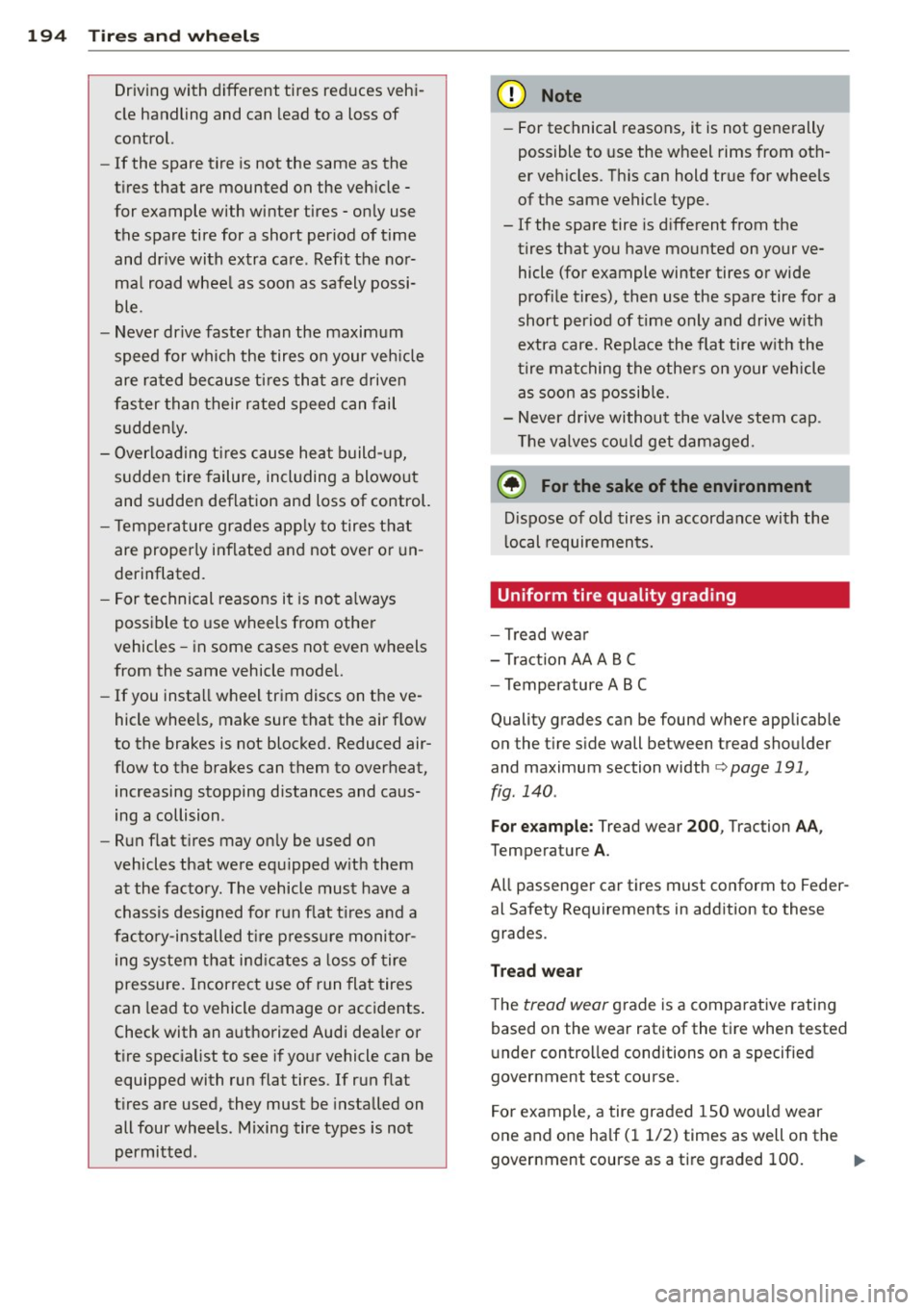
194 Tire s and wheel s
Driving with different tires reduces vehi
cle handling and can lead to a loss of
co ntrol.
- If the spare tire is not the same as the
t ires that are mounted on the veh icle -
for example with winter tires - on ly use
the spare tire for a short period of time
and dr ive with extra ca re. Refit the nor
ma l road whee l as soon as safely possi
ble.
- Never drive faste r than the maximum
speed for which the tires o n your veh icle
are ra ted because ti res th at are driven
faster than their rated speed can fail
sudden ly .
- Over loading t ires c ause heat b uild- up,
sudden tire failure, including a blowout
and sudden deflation and loss of control.
- T emperature grades app ly to tires t hat
are properly inflated and not over o r un
derinflated.
- F or technical reasons it is not a lways
possible to use wheels from other
vehicles -in some cases not even w heels
from the same vehicle model.
- If you insta ll wheel trim discs on t he ve
hicle whee ls, make sure that the air f low
to the brakes is not blocked. Reduced air
flow to the brakes can them to overheat, increasing stopping distances and caus
ing a collision.
- Run flat t ires may on ly be used on
vehicles that were equ ipped w it h them
at the facto ry. The vehicle must have a
chassis des igned for run f lat t ires and a
fac to ry-installed t ire p ress ure moni to r
ing system that ind ic a tes a loss of tire
pressure. Incorrect use of run flat tires
can lead to vehicle damage or accidents .
Check with an a uth orized Audi dea ler or
t i re spec ialist to see i f your vehicle can be
equipped with run flat tires. If r un flat
t ires a re used, they must be installed on
all four wheels . M ixing tire types is not
permitted . (D Note
-For technical reasons, it is not generally
poss ible to use the w heel rims from oth
er ve hicles. T his can hold tr ue for wheels
of the same vehicle type.
- If the spare tire is diffe rent from the
tires that you have mounted on your ve
hicle (for example winter tires or wide
profi le tires), then use the spare tire for a
short period of time only and drive w ith
extra care. Replace the flat tire w it h the
ti re mat ching the othe rs on your vehicle
as soon as possi ble.
- N ever d rive without the valve stem cap.
T he v alves co ul d get damaged.
@ For the sake of the environment
Dis pose of o ld tires in accordance w ith the
l ocal requirements.
Uniform tire quality grading
- Tread wear
- Tra ction AA A B (
- Temperature ABC
Quality grades can be found where applicab le
o n the tire s ide wall between tread shoulder
and maximum section width
¢ page 191,
fig . 140 .
For example: Tread wear 200 , Traction AA,
Temperature A.
All passenger car ti res must conform to Feder
al Safety Req uirements in add ition to these
grades .
Tread wear
The tread wear g rade is a comparative rating
based on the wear rate of the tire when tested
u nder contro lled conditions o n a specified
government test course.
F o r example, a tire gra ded 150 wo uld wear
one and one ha lf (11/2) times as well on the
government course as a ti re graded 100.
Page 202 of 244

200 Tires and wheels
pressure label¢ page 184. Driving on a
significantly under-inflated tire causes the tire to overheat and can lead to tire
failure . Under-inflation also is likely to
impair the vehicle's handling and stop
ping ability .
- The driver is responsible for mainta ining
the correct tire pressures. You must
check the tire pressures regularly.
- Under certain conditions (such as a spor
ty driving style, winter conditions or un
paved roads), the pressure monitor indi
cator may be delayed.
- Ask your author ized Audi dealer if run
flat tires may be used on your veh icle.
Your vehicle registration becomes inval id
if you use these tires when not permit
ted. Damage to your vehicle or accidents
cou ld also resu lt.
- If you switch between standard and run
flat tires, an authorized Audi dealer or
qualified workshop must reprogram the
control module .
@ Tips
-The tire pressure monitoring system may
stop working when there is an ESC mal
funct ion .
- Using snow chains may result in a system
malfunction.
- The tire pressure monitoring system on
your Audi was developed using tires with
the "AO" or "RO" identif ication on the
tire sidewall ¢
page 191. We recom
mend using these tires.
Reset tire pressure monitoring system
(Stepl)
Applies to vehicles: with tire pressure monitoring system
If the tire pressure is adjusted, wheels are ro
tated or changed, the TPMS must be reset in
the menu display.
----- ®
Fig. 142 Wiper lever: Contro ls fo r the menu displ ay
Fig. 143 Disp lay: S tar t m en u
I Reset I button @ and rocker switch @
¢
fig . 142 functions:
To open the menu
" Press the I Rese t I button @ until the men u
disp lay
¢ fig . 143 appears
Selections and settings
" Press the rocker switch @ to reach a menu
disp lay. The switch is operated the same as
the display (up/down) .
Entering and confirming
" Press the I Re set I bu tton @.
Returning to the Start menu
" Press the I Reset I button longer than 2 sec
onds to return from any m enu l evel to the
Start menu.
Page 203 of 244

@ Tips
-Before resetting the TPMS, the current
pressures of
all four tires must corre
spond t o the specified va lues. Adjust the
tire pressu re and reset the pressure in
the tire pressure mon itor ing system ac
cord ing to the load yo u are carry ing
<=> pag e 184.
- Do not store the tire pressure if there are
snow cha ins on the tire . Othe rwise, a
system malfunct ion may occ ur.
Reset tire pressure monitoring system
(Step2}
Applies to vehicles: with tire pressure monitoring system
Fig. 144 D isplay: Tir e press ure
Fi g. 145 Display: Tir e pr ess ure
I Reset ! button @ and rock e r swit ch @
~ page 200, fig . 142 func tions:
Storing tire pressures
.. Turn on the ignition .
.. Select the menu :
> Adjusting * > Tire pres-
sure
> Store .
Entering and confirming
.. Se lect t he menu : St ore now
.,. Press the
l Reset ! button @.
.. Se lect the menu : Confim
Tires and wheels 201
.. Press the I Rese t I button @.
Returning to the Start menu
.,. Press the I R eset I butto n longer than 2 sec
onds to retur n from any menu level to the
S ta rt me nu.
{!) Tips
- B efore resett ing the TP MS, the c urrent
pre ssures o f
all four tires must co rre
spond to t he s pec ified v alue s. A dju st t he
tire pressure and rese t the pressure i n
the tire p ressu re monito ring system ac
co rding to the loa d you are carrying
<=> page 184.
-Do not store the tire p ress ure if there are
snow chains on the tire .
Run-flat ti res
Introduction
Applies to vehicles: with Run -f lat tires
Run-flat tires help keep you moving if a tire
goes flat.
Re inforced sidewalls give the tires run-flat ca
pability if tire pressure is lost .
We recommend that r un-flat tires on ly be
m ounted on vehicles that were orig inally
equipped with these special tires at t he facto
ry and have a Tire Pressure Moni toring Sys
tem .
Run-flat tires can be identified by the letters
"RSC" on the tire sidewall.
If you do change the tires on your veh icle from
norma l to run- flat tires, you must b uy the
special rims required for run-flat tires, and the
T ire Pressure Monitor ing System must be re
programmed by an authorized Aud i dealer o r
other qualified worksho p .
What do run-fl at tires do?
These special tires have r un-flat capabilities
that help keep you moving if a t ire loses pres
sure and goes flat . Under favorable conditions
ti res can be dr iven
at least 30 miles (50 km) ,
but you mus t not dr ive faster than 50 mph Ill-
Page 204 of 244
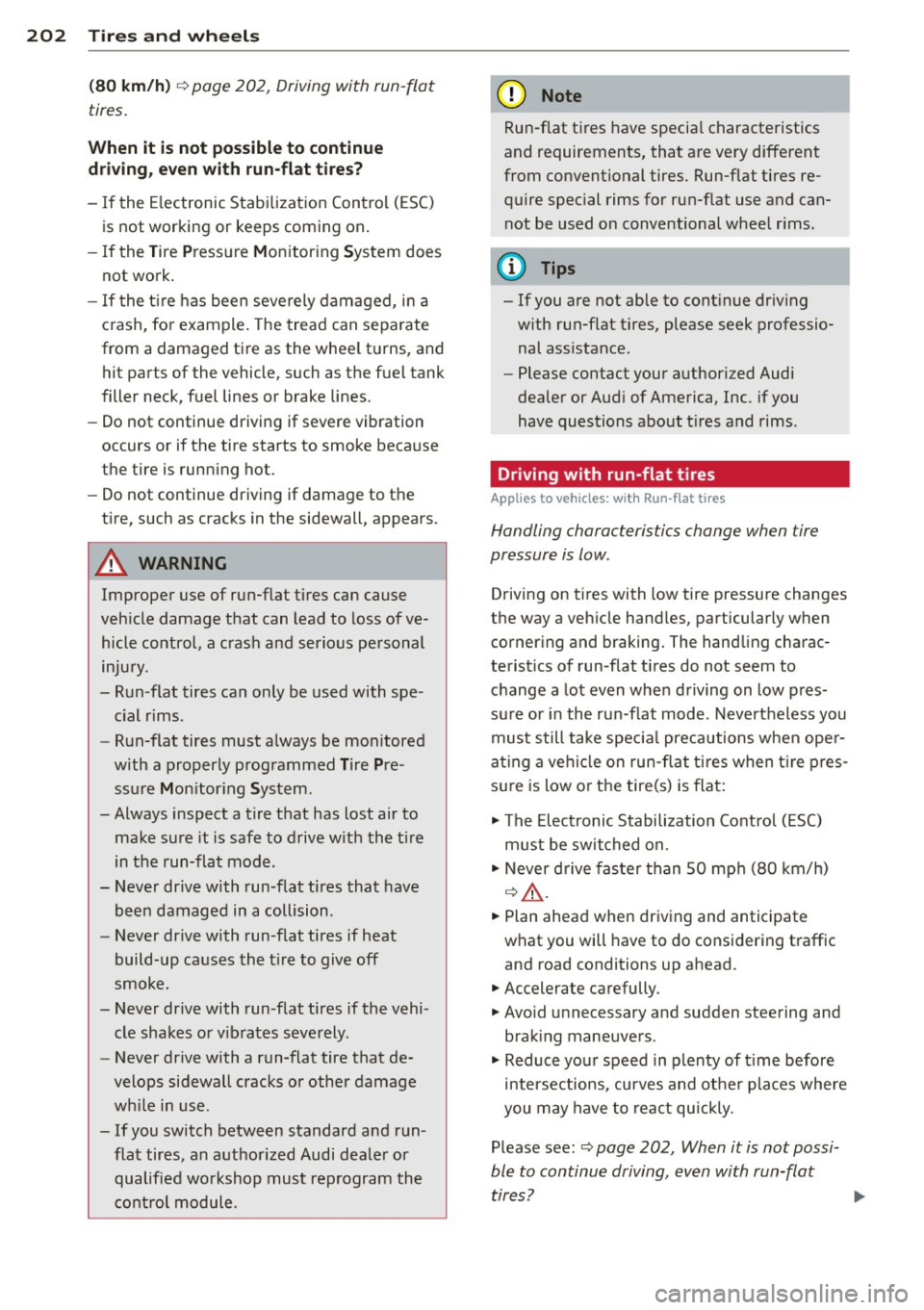
202 Tires and wheels
(80 km/h)
¢ page 202, Driving with run -flat
tires .
When it is not possible to continue
driving, even with run-flat tires?
- If the E lectronic Stabilization Control (ESC)
is not working or keeps coming on.
- If the Tire Pressure Monitoring System does
not work .
-If the tire has been severely damaged, in a
crash, for example. The tread can separate
from a damaged tire as the whee l turns , and
hit parts of the vehicle , such as the fuel tank
filler neck, fuel lines or brake lines.
- Do not continue driving if severe vibration
occurs or if the tire starts to smoke because
the tire is running hot.
- Do not continue driving if damage to the
tire, such as cracks in the sidewall, appears.
A WARNING
Improper use of run-flat t ires can cause
veh icle damage that can lead to loss of ve
hicle control, a crash and serious pe rsonal
injury.
- Run-flat tires can only be used with spe cial rims.
- Run-flat tires must always be mon itored
with a properly programmed Tire
P re
ssure Mon itor ing System.
- Always inspect a tire that has lost air to
make sure it is safe to drive with the tir e
in the run-flat mode.
- Never drive with run-flat tires that have
been damaged in a collision .
- Never drive with run-flat tires if heat
build-up causes the tire to give off
smoke .
- Never drive with run-flat tires if the vehi
cle shakes or v ibrates severely.
- Never drive with a run-flat tire that de
velops sidewall cracks or other damage
wh ile in use .
- If you switch between standard and run
flat tires, an authorized Audi dealer or qualified workshop must reprogram the
control module .
-
(D Note
Run-flat tires have specia l characteristics
and requirements, that are very different
from conventional tires. Run-flat tires re
quire special rims for run-flat use and can
not be used on conventional wheel rims.
(D Tips
- If you are not able to cont inue driving
with run-flat tires, please seek professio
nal assistance.
- Please contact your authorized Audi
dealer or Audi of America, Inc. if you
have questions about tires and rims .
Driving with run-flat tires
Applies to vehicles: wit h Run -flat tires
Handling characteristics change when tire
pressure is low .
Driving on tires with low tire pressure changes
the way a vehicle handles, particularly when
cornering and braking. The handling charac
teristics of run-flat tires do not seem to
change a lot even when driving on low pres
sure or in the run-flat mode . Nevertheless you
must still take specia l precautions when ope r
at ing a vehicle on run-flat tires when tire pres
sure is low o r the tire(s) is flat:
.,. The Electronic Stabilization Control (ESC)
must be switched on.
.,. Never drive faster than 50 mph (80 km/h)
¢&_ .
.,. Plan ahead when driving and anticipate
what you will have to do considering traffic
and road conditions up ahead .
.,. Accelerate carefully.
.,. Avo id unnecessary and sudden steering and
brak ing maneuvers.
.,. Reduce your speed in plenty of time before
intersections, curves and other places where
you may have to react quickly.
Please see :
¢ page 202, When it is not possi
ble to continue driving, even with run-flat
tires?
Page 205 of 244
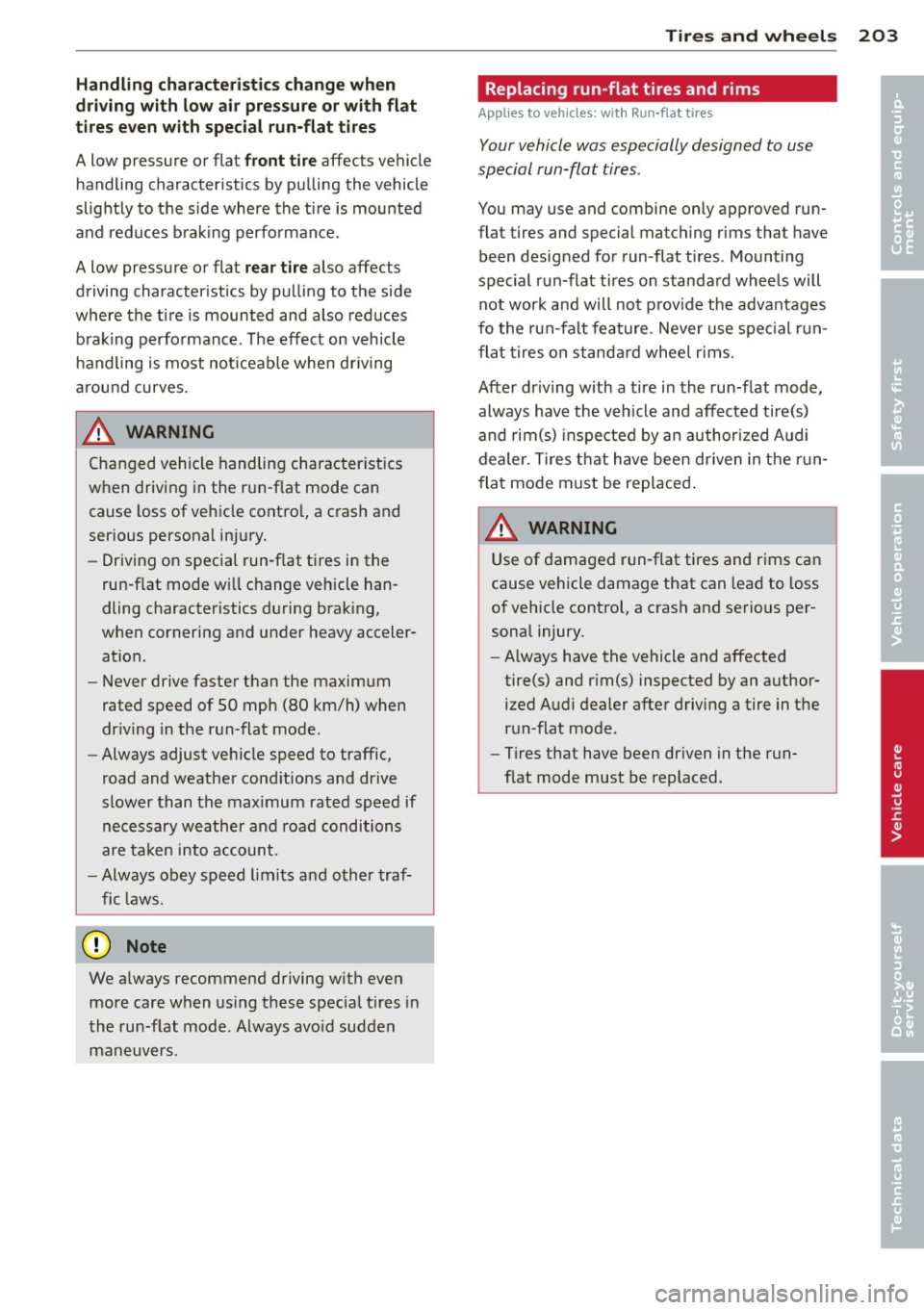
Handling characteristics change when
driving with low air pressure or with flat
tires even with special run-flat tires
A low pressure or flat front tire affects vehicle
handling characteristics by pu lling the vehicle
slightly to the side where the tire is mounted
and reduces braking performance .
A low pressure or flat
rear tire also affects
driving character istics by pulling to the side
where the tire is mounted and also reduces
brak ing performance. The effect on vehicle
handling is most not iceable when driving
around curves.
A WARNING
Changed vehicle handling character istics
when driving in the run -f lat mode can
cause loss of vehicle contro l, a crash and
serious personal injury.
- Driving on special run-flat tires in the
run-f lat mode wi ll change vehicle han
dling characteristics during braking,
when cornering and under heavy acceler
ation.
- Never drive faster than the maximum
rated speed of 50 mph (80 km/h) when
dr iv ing in the run -flat mode.
- Always adjust vehicle speed to traffic,
road and weather cond itions and drive
slower than the max imum rated speed if
necessary weather and road conditions
are taken into account.
- Always obey speed limits and other traf
fic laws.
Q) Note
We always recommend driving w ith even
more care when using these special t ires in
the run-flat mode . Always avo id sudden
maneuvers.
Tires and wheels 203
Replacing run-flat tires and rims
App lies to veh icles : w it h Run -flat t ires
Your vehicle was especially designed to use
special run-flat tires.
You may use and combine only approved run
flat tires and special matching rims that have
been designed for run-flat tires. Mounting
special run-flat tires on standard wheels will not work and w ill not prov ide the advantages
fo the ru n-falt feature . Never use spec ial run
flat tires on standa rd wheel rims.
After dr iving with a tire i n the run-flat mode,
always have the veh icle and affected tire(s)
and rim(s) inspected by a n authorized Audi
dealer. Tires that have been driven in the run
f lat mode must be rep laced .
A WARNING
-Use of damaged run-flat tires and rims can
cause vehicle damage that can lead to loss
of vehicle control, a crash and serious per
sonal injury.
- Always have the vehicle and affected
tire(s) and r im(s) inspected by an author
ized Audi dealer after driving a tire in the
run-flat mode .
- Tires that have been dr iven in the run
f lat mode must be replaced.
•
•
Page 208 of 244
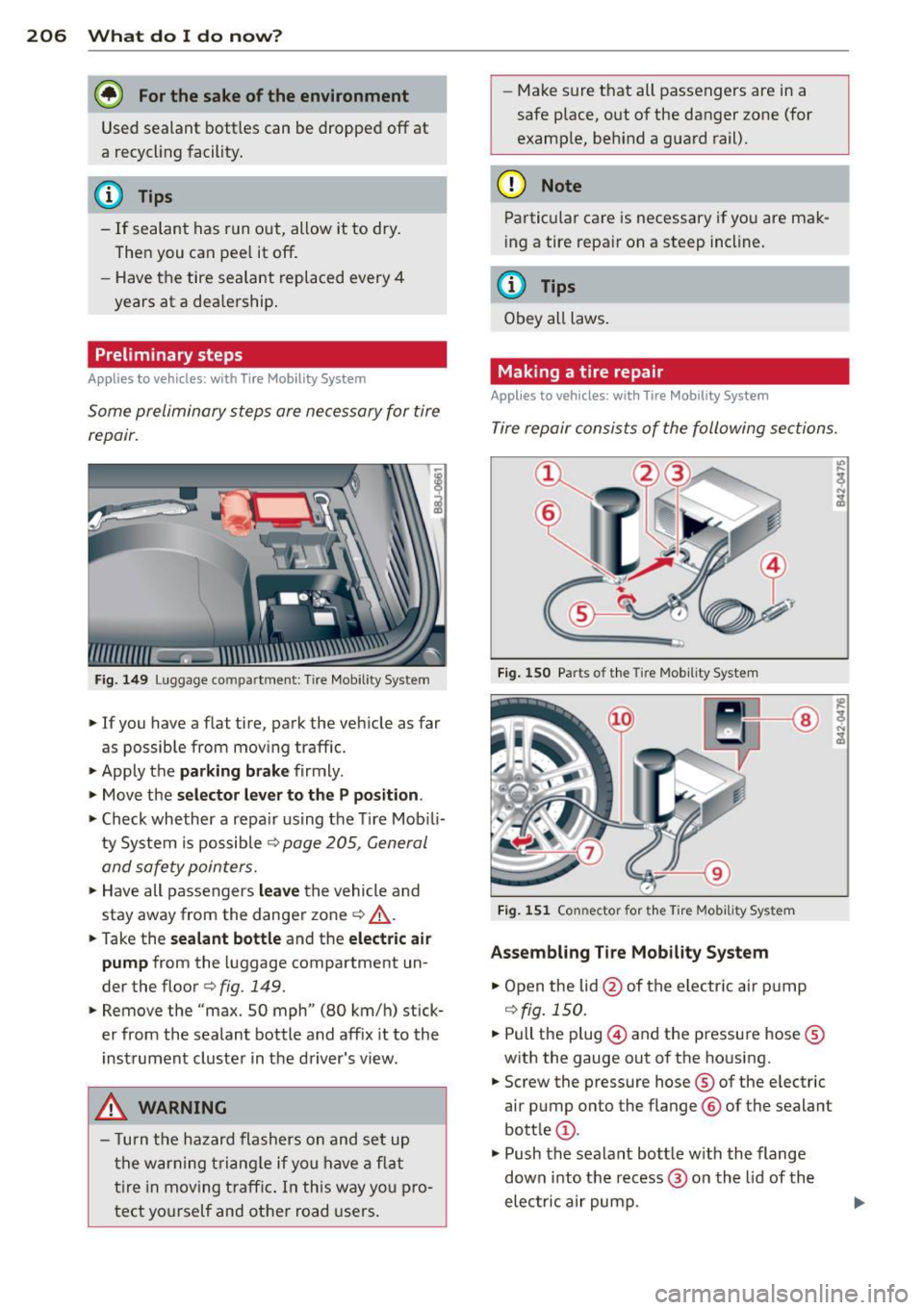
206 What do I do now ?
@ For the sake of the environment
Used sealant bottles can be dropped off at
a recycling facility .
@ Tips
- If sealant has run out, allow it to dry.
Then you can peel it off.
- Have the tire se alant replaced every 4
years at a dea lership .
Preliminary steps
Applies to vehicles: with Tire Mobil ity System
Some preliminary steps are necessary for tire
repair.
Fig. 149 Luggage co mpa rtment : T ir e Mobil ity System
.. If you have a flat tire, park the ve hicle as far
as possible from mov ing traffic .
.. Apply the parking brake firmly .
.. Move the selector lever to the P po sition .
.. Check whether a repa ir using the T ire Mob ili
ty System is possib le
~ page 205 , General
and safety pointers .
.. Have all passengers leave the vehicle and
stay away from the danger zone
c:> /.1. .
.. Take the sealant bottle and the electric air
pump from the luggage compartment un
der the floor
c:> fig. 149 .
.. Remove the "max. 50 mph" (80 km/ h) stick
er from the sealant bottle and aff ix it to the
instrument cluster in the driver's view.
A WARNING
- T urn the ha zard flashers on and set up
t he w arning t ria ng le if you have a fla t
t ire in moving traffic. In this way you pro
tect yo urself and other road users .
-
-Make sure that all passengers are in a
safe place, out of the danger zone (for
example, beh ind a guard rail).
(D Note
Particular care is necessary if you are mak
ing a tire repa ir on a steep incline.
(D Tips
Obey all laws.
Making a tire repair
Appl ies to vehicles: with Tire Mob ility System
Tire repair consists of the following sec tion s.
F ig. 1 50 Parts of t he T ire Mob ility System
Fig. 1 51 Conn ector for th e Tire Mob ility System
As sembling Ti re Mobility System
.. Open the lid@ of the electric air p ump
c:> fig.150 .
.. Pull the plug @) and the pressure hose ®
with the gauge out of the housing .
.. Screw the pressure hose ® of the electric
air pump onto the flange @ of the sealant
bott le @ .
"' Push the sealant bottle w ith the flange
down into the recess @ on the lid of the
elec tric air pump. ..,.
Page 209 of 244
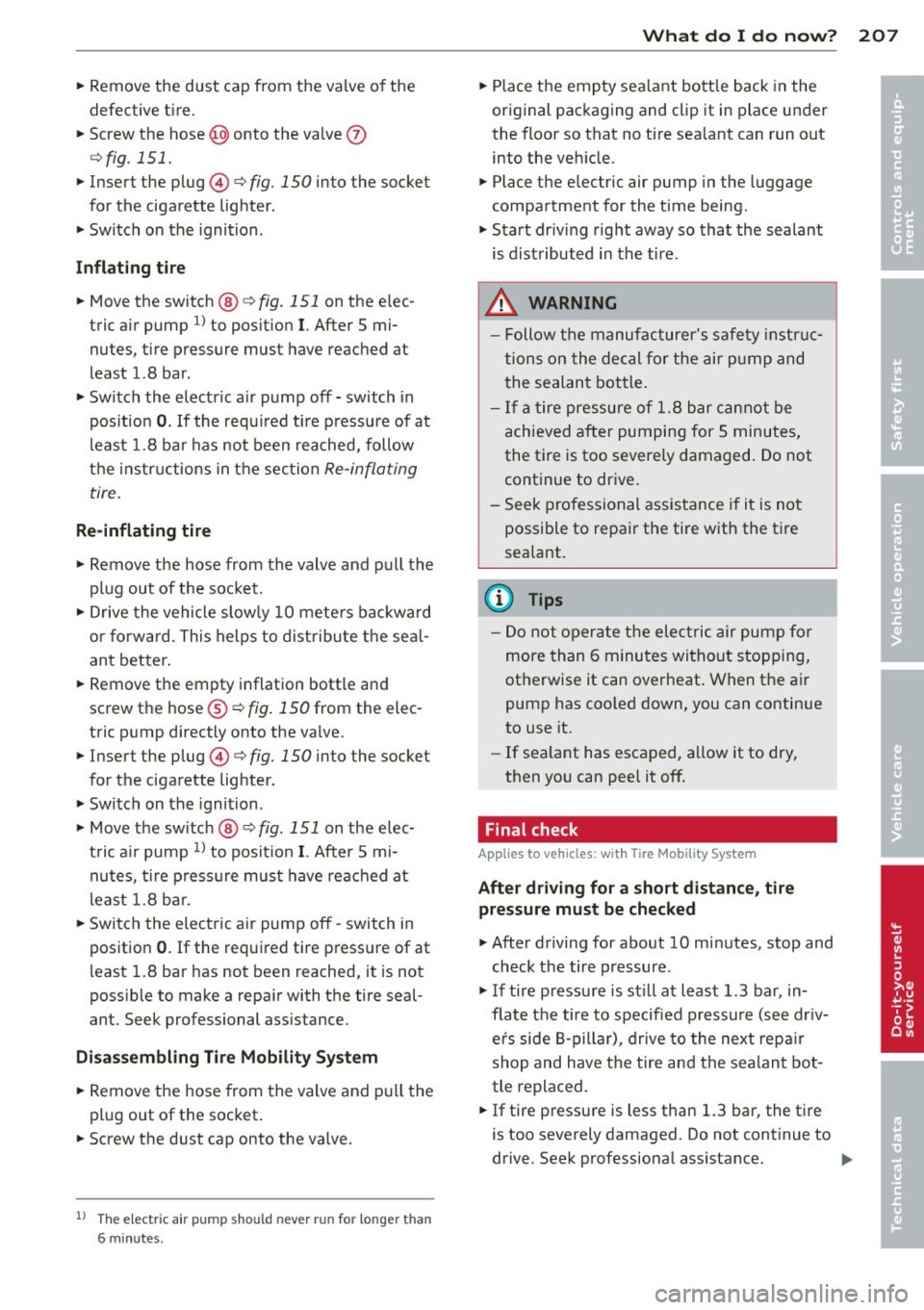
~ Remove the dust cap from the valve of the
defective tire.
~ Screw the hose@) onto the va lve 0
¢ fig . 151.
~ Inser t the plug @¢ fig. 150 into the socket
for the cigarette lighter.
~ Switch on the ignition.
Inflating t ire
~ Move the switch@¢ fig. 151 on the e lec
tric a ir pump
l ) to posit ion I. After 5 mi
nutes, t ire pressure must have reached at
least 1.8 bar .
~ Switch the electric a ir pump off -switch in
pos ition
0 . If the requ ired tire pressure of at
least 1.8 bar has not been reached, follow
the i nstructions in the sec tion
Re-inflating
tire.
Re -inflating tire
~ Remove the hose from the valve and pull the
plug out of the socket.
~ Drive the vehicle slow ly 10 mete rs bac kward
or forward. This helps to dist ribu te t he sea l
ant better .
~ Remove the empty inflation bott le and
screw the hose®¢
fig. 150 from the elec
tric pump directly onto the valve.
~ I nsert the plug@¢ fig. 150 into the socket
for the ciga rette lighter.
~ Switch on the ignition .
~ Move the switch @¢ fig. 151 on the elec
t ric a ir pump
ll to pos it io n I. After 5 mi
nutes, t ire pressure mus t have reached at
least 1.8 b ar.
~ Switch the electric a ir pump off -switch in
position
0 . If the required tire pressure of at
l east 1.8 bar has not been reached, it is not
poss ib le to make a repa ir with the tire seal
ant. Seek professional ass istance.
Disas sembling Tire Mobility System
~ Remove the hose from the valve and p ull the
plug out of the soc ket .
~ Screw the d ust cap onto the va lve.
l ) The e lectr ic a ir pu m p sho uld never r un for lo ng er than
6 m in utes.
What do I do now? 207
~ Place the empty sea lant bott le back in the
original packaging and clip it in place under
the floor so that no tire sea lant can run out
into the veh icle.
~ Place the electric air pump in the luggage
compartment for the t ime being .
~ Start driv ing right away so that the sealant
is dist ributed in the tire.
.&_ WARNING
- Follow the manufacturer 's safe ty inst ru c
tions on the de cal for the ai r pump and
the sealan t bottle .
- If a tire pressure of 1.8 bar cannot be
achieved after pumping for 5 minutes,
the ti re is too severe ly damaged. Do not
continue to drive .
- Seek pro fessional assistance if it is not
possible to repa ir the tire with the t ire
sealant.
(D Tips
- Do not opera te the elec tric air pump fo r
more than 6 minutes without stopping,
otherwise it can overheat . When the ai r
pump has coo led down, you can continue
to use it.
- If sea lant has escaped, allow it to dry,
then yo u can peel it off.
Final check
App lies to vehicles : wi th Tire Mobility Sys tem
After d riv ing for a short d istance , tir e
pressure must be checked
~ After driving for about 10 mi nutes, stop and
check the tire pressure .
~ If tire pressu re is st ill at least 1.3 bar, in
flate the tire to specified press ure (see dr iv
er's side B-pillar), drive to the next repa ir
shop and have the tire and the sealant bot
tle replaced.
~ If tire pressu re is less than 1.3 bar, the t ire
is too severely damaged. Do not continue to
drive . Seek professional assistance. ..,.
•
•